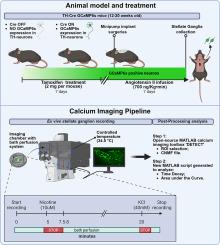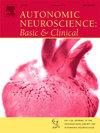完整小鼠星状神经节交感神经元的离体钙成像
IF 3.3
4区 医学
Q2 NEUROSCIENCES
引用次数: 0
摘要
交感神经过度活跃是包括高血压在内的心血管疾病的共同特征,在血管紧张素II (AngII)高血压一周后交感神经过度活跃。神经放电增加细胞内Ca2+,我们想开发一种Ca2+成像方法来量化许多神经元的活动。在这里,我们描述了一种完整的小鼠星状神经节的离体Ca2+成像方法。我们对对照和AngII (700 ng/min/Kg)高血压小鼠的神经节进行成像,以确定我们是否可以识别反映多动症的Ca2+参数。我们在酪氨酸羟化酶(TH)阳性神经元(THGCaMP6s)中表达GCaMP6s。选取17-25周龄的雄性和雌性THGCaMP6s小鼠。分别在基线条件下、尼古丁(10 μM)刺激后和氯化钾(KCl, 40 mM)刺激后获得GCaMP6s表达的图像。差分荧光响应使用开源MATLAB处理工具进行量化。另外编写了MATLAB脚本来分析和表征荧光响应的特征。尼古丁处理后,左星状核的Ca2+反应峰升高,而右星状核的Ca2+反应峰不升高,且左神经节的Ca2+反应峰分布差异显著。各组的衰变时间相似。我们比较了尼古丁治疗与KCl治疗后的Ca2+峰值反应,发现尼古丁的频率分布发生了变化:KCl反应在AngII小鼠的左星状细胞中,而不是在右星状细胞中,这增加了选择性调节胆碱能反应的可能性。钙显像可以同时分析神经节内的多个细胞,但不能概括电生理学鉴定的双侧过度活跃。本文章由计算机程序翻译,如有差异,请以英文原文为准。

Ex vivo calcium imaging of sympathetic neurons in intact mouse stellate ganglia
Sympathetic hyperactivity is a common feature of cardiovascular diseases including hypertension, and sympathetic neurons are hyperactive after a week of angiotensin II (AngII) hypertension. Nerve firing increases intracellular Ca2+ and we wanted to develop a Ca2+ imaging method to quantify activity across many neurons at once. Here we describe a method for ex vivo Ca2+ imaging in intact mouse stellate ganglia. We imaged ganglia from control and AngII (700 ng/min/Kg) hypertensive mice to determine if we could identify Ca2+ parameters that reflected hyperactivity. We expressed GCaMP6s in tyrosine hydroxylase (TH)-positive neurons (THGCaMP6s). Male and female THGCaMP6s mice 17–25 weeks old were used. Images were obtained under baseline conditions, after stimulation with nicotine (10 μM), and after stimulation with potassium chloride (KCl, 40 mM) as a positive control for GCaMP6s expression. Differential fluorescence responses were quantified using an open-source MATLAB processing tool. An additional MATLAB script was composed to analyze and characterize features of the fluorescent responses. The peak Ca2+ response after nicotine treatment trended higher in left but not right stellates from AngII-treated mice, and the distribution of peak responses differed significantly in left ganglia. Decay times were similar in all groups. We compared the peak Ca2+ response after nicotine treatment vs. KCl and found altered frequency distribution of nicotine: KCl responses in left but not right stellates from AngII mice, raising the possibility of selective modulation of cholinergic responses. Calcium imaging allowed simultaneous analysis of multiple cells within ganglia, but did not recapitulate the bilateral hyperactivity identified by electrophysiology.
求助全文
通过发布文献求助,成功后即可免费获取论文全文。
去求助
来源期刊
CiteScore
5.80
自引率
7.40%
发文量
83
审稿时长
66 days
期刊介绍:
This is an international journal with broad coverage of all aspects of the autonomic nervous system in man and animals. The main areas of interest include the innervation of blood vessels and viscera, autonomic ganglia, efferent and afferent autonomic pathways, and autonomic nuclei and pathways in the central nervous system.
The Editors will consider papers that deal with any aspect of the autonomic nervous system, including structure, physiology, pharmacology, biochemistry, development, evolution, ageing, behavioural aspects, integrative role and influence on emotional and physical states of the body. Interdisciplinary studies will be encouraged. Studies dealing with human pathology will be also welcome.

 求助内容:
求助内容: 应助结果提醒方式:
应助结果提醒方式:


